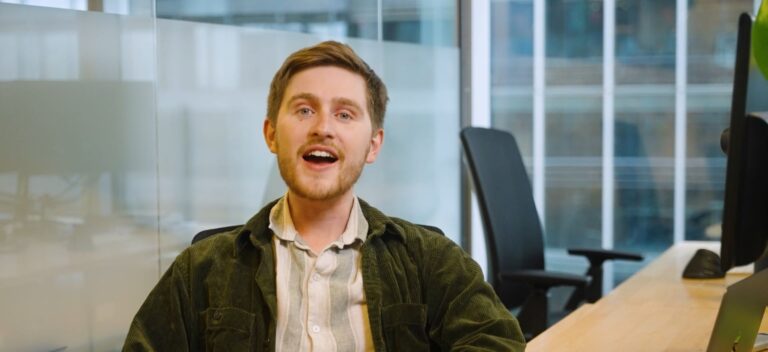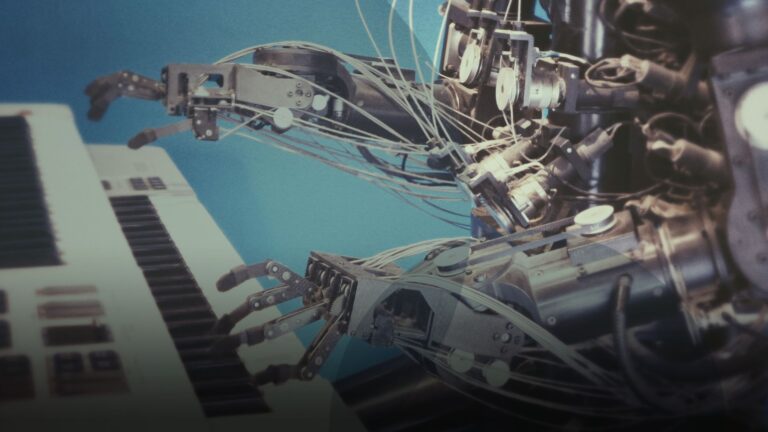
Charlie Stewart
Senior Content Strategist
Charlie brings his creative flair developing content and copywriting across all of our campaigns.

Learn how B2B firms can create authentic, story-driven marketing content that resonates with audiences and builds trust in the age of AI.
View our AI articles and videos
This is a video to help B2B firms improve their content strategy by telling more authentic stories in the age of AI. My name is Charlie Stewart, Senior Content Strategist, and I help organisations figure out and tell their stories every single day. This is about drawing out the kinds of authentic stories your colleagues don’t even know they’re hiding. It’s about getting them to tell those stories in their own words and, perhaps most importantly, keeping them on track to maintain a sense of focus and narrative cohesion.
Which is why we’re going to start by talking about the brief rise and fall of early 2000s English pop-rock band The Hoosiers.
In 2007, The Hoosiers reached number one on the UK charts with hits like Worried About Ray and Goodbye Mr. A. So why did you only just remember that they existed at all? Well, it’s a sad fate that befalls many an aspiring musician. They’ve been writing songs with their friends since they were school kids. In their early twenties, their band finally gets that big break, the chance to put all those songs into a debut album – and the album’s a hit.
But then the pressure’s on. The label wants a second album. And instead of having years of experience to draw on, ages to put those feelings into lyrics, and plenty of time to perfect the melody, they’ve got months. And when they can’t hit the deadline? That’s it. Goodbye, Mr. A – we hardly knew you.
You see a similar thing happen with comedians. Their early material is packed full of sharp observations, but as they become more famous and more removed from the situations that provided them with content to begin with, they struggle. They drift into broad philosophical or social points instead of the grounded material that made them famous.
And the same thing happens in marketing all the time. A business nails its first big campaign because it’s built on real-world stories – founder insights, client results, actual experience. But after that, they try to systematise it, template it, scale it with AI. The lived experience drains away.
That’s a problem not just for your audience, but for your visibility as well. Google’s quality framework, E-E-A-T, doesn’t just want accurate or authoritative content. It wants content that is grounded in first-hand experience. And that’s the one thing a language model can’t generate and a brand can’t fabricate.
Just like in music or comedy, the best content comes from the outside in, not the inside out. When you stop paying attention to the real people around you – your colleagues, your clients, your partners – your stories dry up. Your content gets vague, sanitised, and forgettable. That’s second album syndrome. And you won’t fix it with another AI prompt.
In story-driven marketing, turning inward usually means looking for generic stories that only loosely connect to your point. Here’s an example.
Imagine you work at an energy company and need to write a marketing email to promote a new deal on solar panels. You might start with something like:
The Wright Brothers’ first powered flight lasted just 12 seconds. To some, that might seem like a failure, but just 66 years later, man landed on the moon. Success might not be obvious right away, but by pushing progress in the right direction, we have the chance to change humanity’s future. It’s the same with our new solar panels.
Here’s the thing: that’s not an authentic story. That’s a hook. Hooks have their uses. They’ll grab your audience’s attention in the short term. But they don’t have the authentic connection to another real person that creates lasting impact. Eventually, you’ll run out of hooks. And even if you don’t, your audience will get bored of the formula. In marketing, that’s our equivalent of second album syndrome.
AI is brilliant at generating hooks. It can give you 50 in under a minute. But they won’t connect with your audience unless there’s an authentic, experience-led story underneath.
To avoid second album syndrome in your storytelling, you need to be constantly engaged with the outside world, drawing authentic stories from the people directly connected to what you’re talking about. Think how much more convincing it would be to hear from a homeowner about solar panels – how they lowered their bills and helped them do a bit more for the planet and their children’s future.
Here’s another example. I once did some work for a large UK forecourt operator. Their goal was to recruit more contract managers to run new sites opening across the country. My job was to turn that recruitment push into a compelling story. I couldn’t do it. But the existing contract managers could. By filming them telling their stories in front of the forecourts – with shiny new car washes, EV chargers, all that in the background – we convinced far more people to apply than ever before. It didn’t matter that they weren’t delivering polished speeches. Their authenticity shone through and spoke directly to the right audience.
Now, you might be thinking: if all I need to do is get other people to tell their stories, what’s the point of me being involved at all?
Well, your role is to listen closely and lead people back to the most interesting ideas and details they’ve already shared – even if they don’t realise they’re valuable. To ask questions that, when answered, complete a narrative thread they’ve already started. And, by using your understanding of what makes a good story – relevance, clarity, tension, payoff – you can guide them as they talk, shaping the structure in real time without forcing it.
That requires experience. It requires judgement. It requires someone who knows how to spot the moment that matters and turn it into content the audience actually wants to engage with. And that’s what makes human involvement essential in the age of AI.
AI can help with the prep: planning questions, summarising interviews, suggesting a structure. And it can help after the fact: tidying transcripts, tightening drafts, finding SEO opportunities. But it can’t be in the room. It can’t read nuance. It can’t tell you when something is worth turning into a story. You have to do that yourself.
And if you do it well, it won’t look like much. It’ll just feel like someone shared something real. And your audience will feel that difference. That’s how B2B content stands out today. That’s how it earns trust. That’s how it performs well in search.
And that’s why the best use of AI in content isn’t to replace people – it’s to amplify the people who know how to listen.
Email me at [email protected].

Senior Content Strategist
Charlie brings his creative flair developing content and copywriting across all of our campaigns.
View my other articles and opinion pieces below
Charlie Stewart shares how video content can connect with your audience at the exact moment they’re searching – and why it’s time to treat video as a vital search asset, not just a creative one.

Senior Content Strategist Charlie Stewart shares how Base Creative uses AI to streamline research and content audits – while keeping strategy, creativity, and quality in human hands.

If you’re hoping to create one perfect piece of content so manipulative that it sends your site straight to the top of Google Search, I’ve got some bad news. Exactly how Google’s algorithm works remains a bit of a mystery. What Google has made crystal clear, however, is how its team assesses the quality of […]

This is an article to help you get better at story-driven marketing within your organisation or for your clients. I’m not talking about your old school wishy-washy once upon a time style storytelling. This is about drawing out the kind of authentic stories your colleagues (or clients) don’t even know they’re hiding. It’s about getting […]
